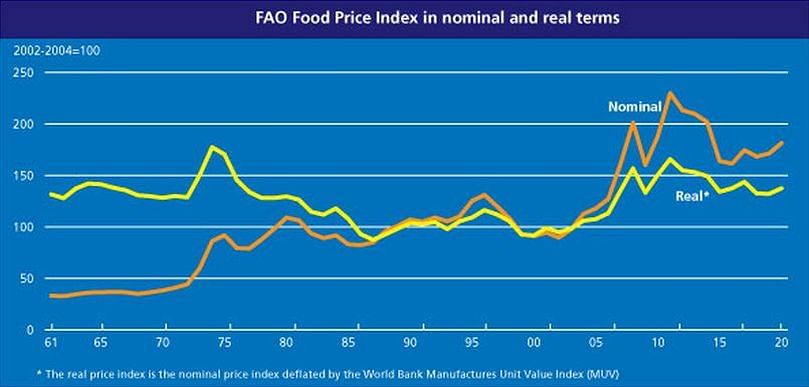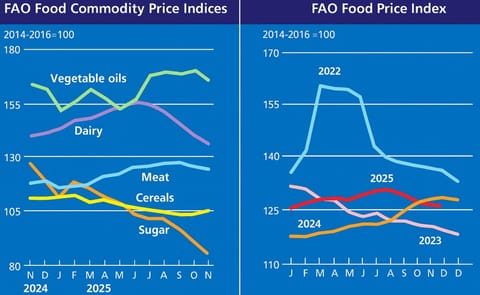FAO Food Price Index declined in February
FAO Food Price Index declined in February

The FAO Food Price Index* (FFPI) averaged 180.5 points in February 2020, down 1.9 points (1.0 percent) from January but still 13.5 points (8.1 percent) higher than in February 2019. The decline marked the first month-on-month drop in the value of the FFPI following four months of successive increases.
It was driven by a sharp fall in the export prices of vegetable oils and, to a lesser extent, meat and grains, more than offsetting a continued rise in dairy and sugar prices.
The FAO Cereal Price Index averaged 167.8 points in February, down 1.5 points (0.9 percent) from January. International prices of all major cereals, except rice, fell in February.
Wheat prices were generally lower, in part due to continued well-supplied markets while the negative impact on demand resulting from the spread of the coronavirus (COVID-19) also contributed to the price decline.
Maize prices retreated too, influenced by expectations of weaker demand from the feed sector due to overall deteriorating economic prospects. By contrast, international rice prices increased for the second consecutive month, underpinned by tight exportable availabilities in the Americas and Viet Nam, coupled with strong demand from the Far Eastern and East African buyers.
The FAO Vegetable Oil Price Index averaged 158.1 points in February, down 18.2 points (or 10.3 percent) from January and interrupting the upward trend recorded since July 2019. The sharp drop was led by palm oil, the dominant component of the index.
International palm oil quotations fell by 12 percent month-on-month on higher than expected output in Malaysia, a temporary drop in Indian import demand and fears of a slowdown in global demand following the outbreak of COVID-19.
Soy, sunflower and rapeseed oil prices followed palm oil downwards amid COVID-19 related concerns and, in the case of soyoil, reports of larger than anticipated inventories in the United States.
The FAO Dairy Price Index averaged 209.8 points in February, up 9.2 points (4.6 percent) from January, rising for the fourth consecutive month and placing the index at 17.4 points (9.0 percent) above its value in the corresponding month last year.
In February, price quotations for cheese surged by as much as 20 points (10.6 percent), underpinned by the tightening of export supplies from New Zealand with the seasonal milk production decline, further accentuated by reduced export availabilities from Australia due to less than average milk output in the 2019/20 season.
By contrast, quotations for skim powder (SMP) and whole milk powder (WMP) declined due to a slowdown in purchases by China – the world’s largest milk powder importer – in view of the delays in cargo handling in ports, affected by the spread of the coronavirus.
The FAO Meat Price Index* averaged 178.6 points in February, down 3.7 points (2.0 percent) from January, marking the second month of decline, following 11 months of moderate increases. At this level, the index value was 15.9 points (9.8 percent) above the corresponding month last year.
In February, international prices of ovine meat fell the most, followed by bovine meat, primarily due to reduced imports by China, reflecting delays in cargo handling in ports, which, in turn, led to stock build up in major exporting countries. Drought-induced slaughter in New Zealand also weighed on international quotations for ovine meat.
Current import demand for pig meat eased from its earlier highs, but some supply tightness in Europe pushed up prices marginally. Poultry meat prices came under slight downward pressure due to lower purchases by Asia.
The FAO Sugar Price Index averaged 209.7 points in February, up 9.0 points (4.5 percent) from January, marking the fifth consecutive monthly increase and the highest level since May 2017. The latest increase mostly reflected the prospects of lower production in India, the world’s second largest sugar producer, as well as in Thailand due to protracted drought.
Strong global import demand, notably from Indonesia, the world’s largest sugar importer, also provided support to prices. However, the continuous weakness of the Brazilian currency (Real) against the United States Dollar limited the extent of the rise in world sugar prices.









